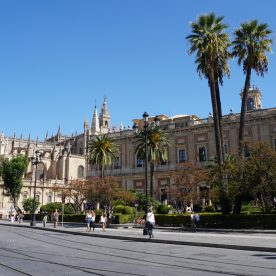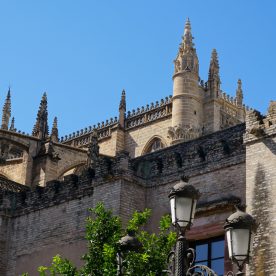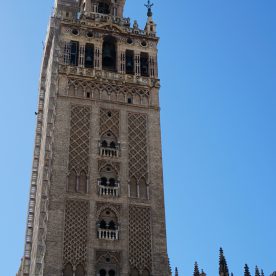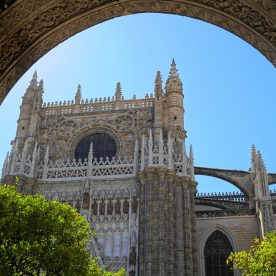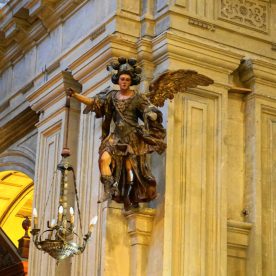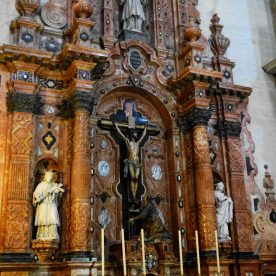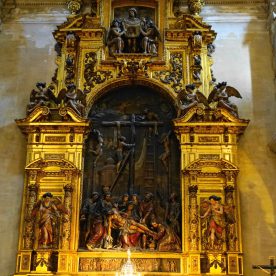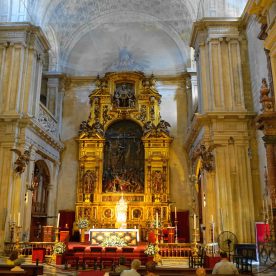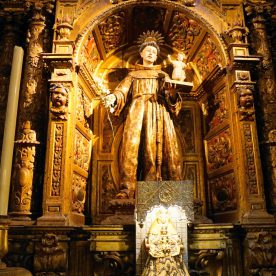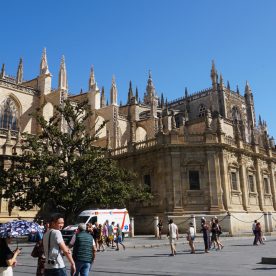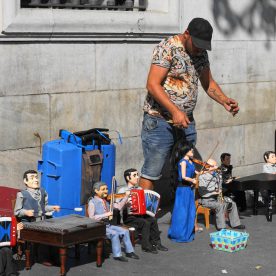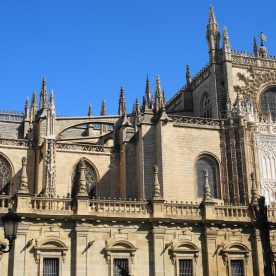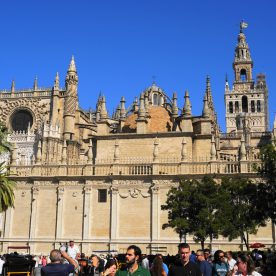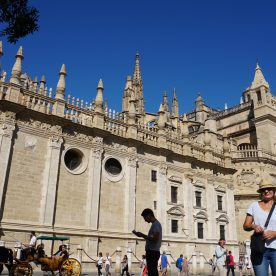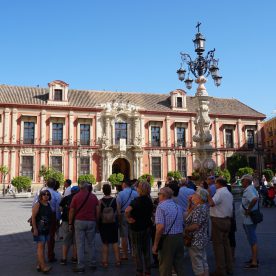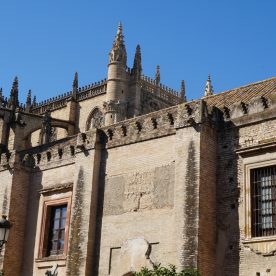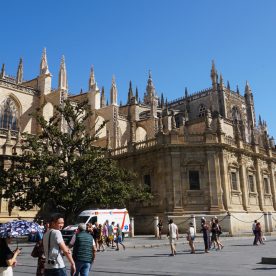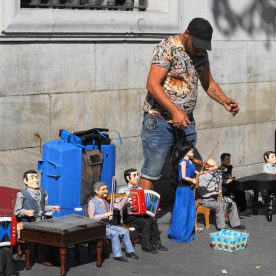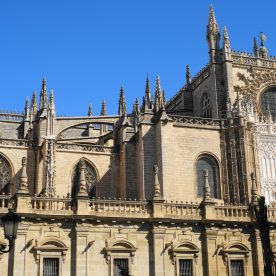Seville’s immense cathedral is awe-inspiring in its scale and majesty. The world’s largest Gothic cathedral, it was built between 1434 and 1517 over the remains of what had previously been the city’s main mosque. Highlights include the Giralda, the mighty bell tower, which incorporates the mosque’s original minaret, the monumental tomb of Christopher Columbus, and the Capilla Mayor with an astonishing gold altarpiece. The history of the cathedral goes back to the 15th century but the history of Christian worship on the site dates to the mid-13th century. In 1248, the Castilian king Fernando III captured Seville from its Almohad rulers and transformed their great 12th-century mosque into a church. Some 153 years later, in 1401, the city’s ecclesiastical authorities decided to replace the former mosque, which had been damaged by an earthquake in 1356, with a spectacular new cathedral: ‘Let’s construct a church so large future generations will think we were mad’, they quipped (or so legend has it).
The result is the staggering cathedral you see today, officially known as the Catedral de Santa María de la Sede. It’s one of the world’s largest churches and a veritable treasure trove of art, with notable works by Zurbarán, Murillo, Goya and others.
Exterior
From close up, the bulky exterior of the cathedral with its Gothic embellishments gives hints of the treasures within. Pause to look at the Puerta del Perdón (now the cathedral’s exit) on Calle Alemanes. It’s one of the few remaining elements from the original mosque.
Sala del Pabellón
Selected treasures from the cathedral’s art collection are exhibited in this room, the first after the ticket office. Much of what’s displayed here, as elsewhere in the cathedral, is the work of masters from Seville’s 17th-century Golden Age.
Tomb of Christopher Columbus
Once inside the cathedral proper, head right and you’ll see the tomb of Christopher Columbus (the Sepulcro de Cristóbal Colón) in front of the Puerta del Príncipe (Door of the Prince). The monument supposedly contains the remains of the great explorer, but debate continues as to whether the bones are actually his.
Columbus’ remains were moved many times after his death (in 1506 in Valladolid, northern Spain), and there are those who claim his real bones lie in Santo Domingo. Certainly his bones spent time in the Dominican Republic after they were shipped to Spanish-controlled Hispaniola from their original resting place, the Monasterio de la Cartuja, in 1537. However, they were later sent to Havana and returned to Seville in 1898.
DNA testing in 2006 proved a match between the bones supposed to be Columbus’ and bones known to be from his brother Diego. And while that didn’t conclusively solve the mystery, it strongly suggested that the great man really is interred in the tomb that bears his name.
Sacristía de los Cálices
To the right of Columbus’ tomb are a series of rooms containing some of the cathedral’s greatest masterpieces. First up is the Sacristy of the Chalices, where Francisco de Goya’s painting of the Sevillan martyrs, Santas Justa y Rufina (1817), hangs above the altar.
Sacristía Mayor
Next along is this large room with a finely carved stone cupola, created between 1528 and 1547: the arch over its portal has carvings of 16th-century foods. Pedro de Campaña’s 1547 El descendimiento (Descent from the Cross), above the central altar at the southern end, and Francisco de Zurbarán’s Santa Teresa, to its right, are two of the cathedral’s most precious paintings. Also look out for the Custodia de Juan de Arfe, a huge 475kg silver monstrance made in the 1580s by Renaissance metalsmith Juan de Arfe.
Sala Capitular
The circular chapter house, also called the Cabildo, features a stunning carved dome and a Murillo masterpiece, La inmaculada, set high above the archbishop’s throne. The room was built between 1558 and 1592 as a venue for meetings of the cathedral hierarchy.
Capilla Mayor
Even in a church as spectacular as this, the Capilla Mayor (Main Chapel) stands out with its astonishing Gothic retable, reckoned to be the world’s largest altarpiece. Begun by Flemish sculptor Pieter Dancart in 1482 and finished by others in 1564, this sea of gilt and polychromed wood holds more than 1000 carved biblical figures. At the centre of the lowest level is a tiny 13th-century silver-plated cedar image of the Virgen de la sede (Virgin of the See), patron of the cathedral.
West of the Capilla is the Choir into which is incorporated a vast organ.
Southern & Northern Chapels
The chapels along the southern and northern sides of the cathedral hold yet more artistic treasures. Of particular note is the Capilla de San Antonio, at the western end of the northern aisle, housing Murillo’s humongous 1656 depiction of the vision of St Anthony of Padua. The painting was victim of a daring art heist in 1874.
Giralda
In the northeastern corner of the cathedral you’ll find the entry to the Giralda. The climb to the top involves walking up 35 ramps, built so that the guards could ride up on horseback, and a small flight of stairs at the top. Your reward is sensational rooftop views.
The decorative brick tower, which tops out at 104m, was the minaret of the mosque, constructed between 1184 and 1198 at the height of Almohad power. Its proportions, delicate brick-pattern decoration and colour, which changes with the light, make it perhaps Spain’s most perfect Islamic building. The topmost parts – from bell level up – were added in the 16th century, when Spanish Christians were busy ‘improving on’ surviving Islamic buildings. At the very top is El Giraldillo, a 16th-century bronze weathervane representing ‘faith’, that has become a symbol of Seville.
Patio de los Naranjos
Outside the cathedral’s northern side, this patio was originally the mosque’s main courtyard. It’s planted with 66 naranjos (orange trees), and has a small Visigothic fountain in the centre. Look out for a stuffed crocodile hanging over the courtyard’s doorway – it’s a replica of a gift the Sultan of Egypt gave Alfonso X in around 1260.
